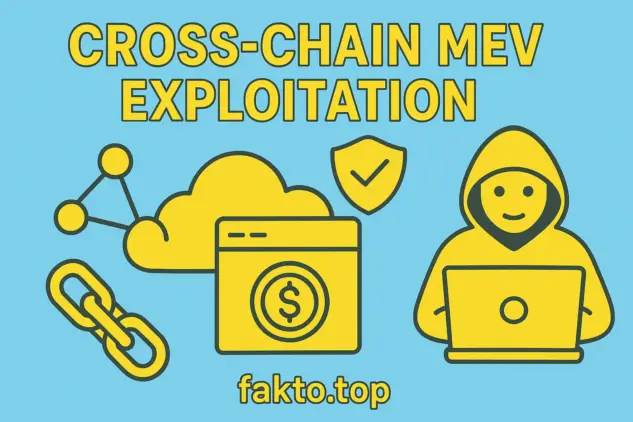Cross-Chain MEV Exploitation: How to Avoid The Silent Bridge Tax
Stop The Steal: Why Your Assets Lose Value When Bridging Chains via MEV Bots
Every time you move your crypto across blockchains, a small, invisible thief might be taking a slice of your money. You won’t see a transaction fee labeled “MEV,” but it’s there — quietly siphoning value from your transfer. This phenomenon, known as Cross-Chain MEV Exploitation, reveals the hidden mechanics that extract profit silently from cross-chain transactions. Welcome to the hidden world of Maximal Extractable Value, the silent tax that bleeds your assets when they cross chains.

At first glance, bridging seems simple. You lock tokens on one chain and receive their representation on another. But beneath that elegant surface lies a battlefield — filled with searchers, relayers, and validators competing to extract every bit of profit from your transaction. This competition manifests as MEV: front-running, sandwiching, and reordering of your transaction in ways you’ll never notice… until you compare the before-and-after balances.
Anatomy of The Bridge Tax: MEV as Frontrunning and Sandwiching Attacks During Cross-Chain Relaying
Think of your cross-chain transaction like sending valuable cargo across a sea infested with digital privateers. Every single hop—every time your assets move between blockchains—a decentralized predator is waiting. MEV bots are those privateers, strategically reordering and intercepting transactions to profit from predictable token movements.
When you initiate a bridge transfer, your intent goes into the public mempool. Specialized bots instantly scan this public waiting room for profitable patterns—such as a large swap or a bridge event that will inevitably create an arbitrage opportunity on the destination chain. These MEV bots act in milliseconds, essentially front-running your transaction. They execute their own profitable trades before your transfer completes, causing slippage or changing token prices in the process.
The Silent Tax: How MEV Drains Your Value
From the outside, this process often looks like normal market activity. But for the user, it’s a silent tax. You bridge 1 ETH, and when it lands, its value is slightly less than expected. This loss isn’t due to volatility or standard fees, but because an invisible algorithm exploited the transaction’s predictability. This is the definition of value leakage.
The bridge tax operates across multiple vulnerability layers. There’s the initial mempool exposure (where your intent becomes public), the relayer layer (where transactions are batched and sequenced), and the confirmation layer (where timing affects the final price you receive). Each of these points is a potential hook for MEV extraction.
Some bridges are naturally riskier than others. Native bridges often rely on predictable validator sequencing, while third-party bridges (like LayerZero or Wormhole) use relayers and oracles, introducing different—but equally exploitable—timing windows. MEV doesn’t discriminate; it only hunts opportunities.
Consider a simple scenario: you move USDC from Ethereum to BNB Chain. A bot anticipates this large move will create a momentary liquidity imbalance on the destination chain. It buys USDC just before your funds arrive and sells it seconds after your transfer lands, profiting from the price adjustment your action caused. Your loss comes not from fees, but from invisible slippage.
Multiply this by millions of bridge transfers daily, and you get a shadow economy worth billions—a critical flaw invisible to most retail users. MEV is currently tolerated because it enforces market efficiency but severely punishes predictability. Until recently, awareness was the only defense. Now, adopting private transaction methods is becoming essential to reclaim that lost value.
Defensive Wallet Settings: How to Use Private Transaction Pools (Flashbots) for Bridging
The best way to beat the invisible tax is to stop broadcasting your financial intentions in public. This is exactly what private transaction pools — like Flashbots Protect — are designed for. Instead of submitting your transaction to the open mempool, you send it privately to a block builder who includes it directly in a block without exposing it to MEV bots.
For cross-chain transfers, this means your bridge transaction becomes invisible until it’s already confirmed. No frontrunning, no sandwiching, no predictive attacks. You essentially cloak your assets in transit.
Modern wallets like MetaMask, Rabby, and Frame now offer options for private RPC endpoints. Enabling these is simple but powerful — a single switch that can save you measurable money on every transfer. Think of it as enabling stealth mode for your crypto moves.
Flashbots work by creating a direct communication line between the user and block builder, bypassing the mempool entirely. Your transaction still competes for inclusion but without public exposure. The builder is incentivized to include it because they get paid directly for the block space — not by arbitraging your trade.
However, not every bridge supports this yet. Some protocols still rely on visible relay layers where MEV can creep back in. This is why choosing the right bridge protocol matters just as much as using the right wallet settings. In the next section, we’ll compare how different cross-chain protocols handle MEV risk and which ones deserve your trust.
If you take one thing from this section, let it be this: never bridge in public. Every open mempool is a marketplace of intentions, and the most predictable trader always loses. Privacy isn’t paranoia — it’s profit preservation.
Protocol Risk Comparison: Native Bridges vs Third-Party Protocols Based on MEV Exposure
Not all bridges are born equal. Some are engineered with transparency that unintentionally feeds MEV bots, while others integrate cryptographic tricks to minimize visibility. To understand your risk, you need to know how each bridge type handles transaction sequencing and information disclosure.
Native bridges — like Ethereum’s canonical rollup bridges (Arbitrum, Optimism) — operate directly on the base layer. They’re secure in terms of consensus, but they expose transactions publicly as they pass through the main chain. MEV bots love this predictability. Every withdrawal, every message relay, is open for timing manipulation. So, while native bridges offer the strongest security guarantees, they also provide the most fertile ground for MEV harvesting.
Third-party protocols, such as LayerZero and Wormhole, attempt to solve this by introducing relayers and oracles. They verify and deliver messages between chains using off-chain agents. But that introduces a new kind of risk: centralization of relayers and potential data leaks during verification. If a relayer network is predictable or colluding, it can enable timing-based MEV extraction even faster than public mempools. The tradeoff is simple — less visibility for bots, more reliance on trust assumptions.
Hybrid systems — like Axelar or Synapse — take a middle ground. They blend on-chain proofs with off-chain validation, trying to balance speed, security, and privacy. Their MEV exposure depends largely on implementation. Some integrate private relay layers, others use zero-knowledge proofs to obscure details until the transaction is final.
Here’s a simplified overview of MEV risk by bridge type:
| Bridge Type | Primary Mechanism | MEV Exposure | Recommended Use Case |
|---|---|---|---|
| Native Bridge (e.g., Arbitrum, Optimism) | Direct L1 relay with on-chain proofs | High | When maximum security outweighs minor MEV loss |
| Third-Party Bridge (LayerZero, Wormhole) | Off-chain oracles and relayers | Medium to High | For fast transfers with moderate security assumptions |
| Hybrid (Axelar, Synapse) | Mixed on/off-chain verification | Medium | When balancing speed, privacy, and decentralization |
| MEV-Resistant Bridge (Experimental) | Private relay or ZK-delayed proofs | Low | When privacy and value preservation are top priorities |
Numbers tell the story: the bridges that hide information the longest usually retain the most value. The less your transaction can be predicted, the less MEV it attracts. MEV is like mold — it grows where sunlight hits. Shadow your moves, and it can’t find you.
Another factor to consider is how confirmation delays affect MEV exposure. Fast bridges often trade off security for immediacy, which can increase timing-based attacks. On the other hand, slower bridges, which require multiple confirmations, create more opportunities for frontrunning before the final execution. Ironically, “faster” doesn’t always mean safer.
Community-driven projects like Skip Protocol and MEV Blocker are trying to extend MEV protection into the cross-chain ecosystem. They’re still experimental, but they hint at a future where bridging will be as private as signing an offline transaction.
MEV exploitation isn’t the only risk when using cross-chain bridges. To truly understand your exposure and manage overall transaction costs, we provide an analytical breakdown of the full L2 withdrawal cost and gas strategy required to return assets to the Ethereum base layer.
Q&A: Your MEV Safety Toolkit
Q: Is it safer to use a CEX to move assets between chains?
In pure MEV terms — yes, centralized exchanges (CEXes) eliminate on-chain exposure because transactions happen inside their internal ledger. No mempool, no frontrunning. But that safety comes with a tradeoff: you lose self-custody. Your assets are secure only as long as the exchange stays solvent and honest. For small, tactical transfers, a CEX bridge may be pragmatic. For long-term trustless ownership, stick to private, MEV-resistant on-chain routes.
Q: How does Flashbots prevent MEV?
Flashbots prevent MEV by cutting off the information leak at its source. When you use a Flashbots endpoint (like through MetaMask’s “private RPC” option), your transaction skips the public mempool and goes directly to a block builder. This builder then includes it in a block without broadcasting it publicly. Because bots never see your transaction before it’s confirmed, they can’t front-run or sandwich it. It’s like mailing your package straight into the vault instead of leaving it on the porch.
Flashbots don’t eliminate MEV globally — they just shield your activity from becoming its source. When combined with bridges or protocols that support private relays, it becomes a powerful weapon against invisible losses.
Some developers are experimenting with “cross-chain Flashbots” concepts — private transaction bundles that span multiple networks through cryptographic coordination. If successful, these could create a seamless MEV-free experience across Ethereum, Solana, and beyond. Until then, users need to combine existing tools: private RPCs, MEV blockers, and bridges that delay exposure.
In short: CEXes offer temporary escape, Flashbots offer stealth, and education offers permanence.
Conclusion
The bridge you choose determines more than speed — it determines how much of your value quietly leaks into the dark economy of MEV bots. The invisible “bridge tax” isn’t random theft; it’s a predictable byproduct of transparency. But transparency isn’t your friend when others can weaponize it against you.
Defend yourself by combining private transaction routing, MEV-aware wallets, and bridge protocols that respect user privacy. Experiment with tools like Flashbots, MEV Blocker, or hybrid relays that obscure intent. And remember: in the complex world of crypto, knowledge is your only edge. By applying these specific metrics and tools, you move from being a user susceptible to hidden losses to a proactive investor who understands and controls their risk.
Disclaimer
This article is provided for educational and informational purposes only. It does not constitute financial advice or an endorsement of any specific protocol or wallet. Cryptocurrency investments and transfers involve risks, including technical vulnerabilities, market volatility, and potential loss of funds. Always conduct your own research and consult with a qualified professional before making any financial decisions.

